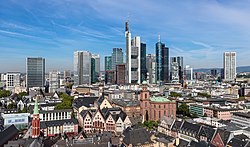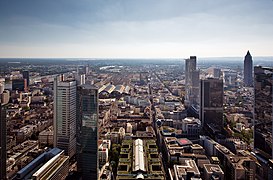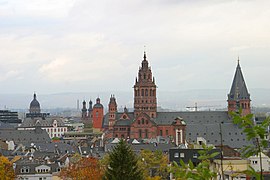Франкфурт Рейн-Мейн
Рейн-Мейн Столичный регион
Рейн-Мейн Район | |
|---|---|
 Центр Франкфурта | |
 Location of Rhine-Main Metropolitan Region in Germany | |
| Country | |
| States | |
| Largest cities | Frankfurt am Main Wiesbaden Mainz Darmstadt |
| Government | |
| • Type | Frankfurt/Rhine-Main Conurbation Planning Association |
| • Verbandsdirektor | Thomas Horn (CDU) |
| Area | |
| • Metro | 14,800 km2 (5,700 sq mi) |
| Population (2019)[2] | |
| • Metro | 5,808,518 |
| • Metro density | 390/km2 (1,000/sq mi) |
| GDP | |
| • Metro | €300.868 billion (2021) |
| Time zone | UTC+1 (CET) |
| Website | Planungsverband.de |
, Метрополитен Рейн-Мейн часто называемый Франкфуртом Рейн-Мейн , Франкфуртом Рейн-Мейн или Райном Мейн (немецкий: Рейн-Мейн-Гебиет или Франкфурт/Рейн-Мейн , сокращенная FRM ) является вторым -является вторым-является вторым-является вторым-является вторым-является вторым-является вторым-является вторым-является вторым-вторым Крупнейший столичный регион в Германии после Рейн-Рур , причем общая численность населения превышает 5,8 миллиона. Столичный регион расположен в центральной западной части Германии, и простирается над частями трех немецких штатов : Гессе , Рейнленд-Палатинат и Бавария . Крупнейшими городами в регионе являются Франкфурт А.М. Мейн , Висбаден , Майнц , Дармштадт , Оффенбах , Черви , Ханау и Ашаффенбург .
Полицентричный регион назван в честь его основного города, Франкфурта, и двух рек Рейн и Майн . Район Франкфурта Рейн-Мейн официально назначен европейским столичным регионом Федеральным министерством транспорта, строительства и городских дел Германии и охватывает площадь примерно 13 000 квадратных километров (5000 кв. Миль).
The region is the 4th biggest by GDP in the European Union.
Subdivisions
[edit]Although Rhine-Main is considered to be a polycentric metropolitan region, the economic size and political weight of the city of Frankfurt sets it into a very monocentric relation with her commuter belt. Since the early 1970s, the Frankfurt am Main metropolitan area (German: Ballungsraum Frankfurt/Rhein-Main) is defined as the area encompassing the cities of Frankfurt and Offenbach and their directly neighboring districts.[citation needed]
The Regierungsbezirk Darmstadt of the state of Hesse could be seen as the next administrative division, for it lies entirely within the metropolitan region and further includes the cities of Darmstadt and Wiesbaden along with a number of larger districts. Only on a level further, the metropolitan region also includes the cities and districts of Mainz and Aschaffenburg in the two adjoining federal states of Rhineland-Palatinate and Bavaria.[4]
Metropolitan region and larger urban zones
[edit]Eurostat's 'Urban Audit' splits the Frankfurt Rhine-Main region into four Larger Urban Zones (LUZ). These zones do exclude a number of districts in the metropolitan area.
| Urban zone | Major cities | Population | Area |
|---|---|---|---|
| Frankfurt am Main urban zone[5] | 2,729,562 | 4,305 km2 | |
| Frankfurt am Main | 773,068 | 248 km2 | |
| Offenbach am Main | 134,170 | 45 km2 | |
| Wiesbaden urban zone | 462,098 | 1,015 km2 | |
| Wiesbaden | 283,083 | 204 km2 | |
| Darmstadt urban zone | 439,084 | 781 km2 | |
| Darmstadt | 162,243 | 122 km2 | |
| Mainz urban zone | 403,849 | 704 km2 | |
| Mainz | 218,578 | 98 km2 | |
| Rhine-Main | 5,808,518 | 14,755 km2 | |
Cities and districts
[edit]| Picture | City or district | Area | Population |
|---|---|---|---|

|
Frankfurt am Main | 248 km2 | 750,000 |

|
Offenbach am Main | 45 km2 | 118,245 |
| Landkreis Offenbach | 356 km2 | 337,986 | |

|
Main-Kinzig-Kreis | 1,397 km2 | 411,956 |

|
Wetteraukreis | 122 km2 | 142,191 |

|
Hochtaunuskreis | 482 km2 | 233,427 |

|
Main-Taunus-Kreis | 122 km2 | 142,191 |

|
Darmstadt | 122 km2 | 142,191 |

|
Landkreis Darmstadt-Dieburg | 659 km2 | 289,102 |

|
Landkreis Groß-Gerau | 453 km2 | 253,502 |

|
Wiesbaden | 204 km2 | 275,489 |

|
Rheingau-Taunus-Kreis | 98 km2 | 196,784 |
| Subtotal | Hesse | 7,445 km2 | 3,778,689 |

|
Mainz | 98 km2 | 196,784 |

|
Mainz-Bingen | 606 km2 | 201,451 |

|
Worms | 109 km2 | 81,784 |
| — | Landkreis Alzey-Worms | 588 km2 | 124,758 |
| Subtotal | Rhineland-Palatinate | 1405 km2 | 604,777 |

|
Aschaffenburg | 63 km2 | 68,646 |
| — | Landkreis Aschaffenburg | 699 km2 | 173,946 |

|
Landkreis Miltenberg | 716 km2 | 130,009 |
| Subtotal | Bavaria | 1,478 km2 | 372,601 |
| Total | Frankfurt Rhine-Main metropolitan region | 14,800 km2 | 5,800,000 |
Economy
[edit]
With its central location in southwestern Germany, the Frankfurt Rhine-Main region has been an important industrial and transport center since industrialization began in the mid-19th century. The region is a major financial center of both Germany and Europe, with the European Central Bank headquartered in Frankfurt am Main. In 2018, about 7.9% of Germany's gross domestic product (GDP) was generated in the region, as well as over three-fourths of the state of Hesse's GDP.[6]
In addition to banking and finance, the chemical industry has had a long established presence in the metropolitan region, with the Industriepark Höchst (Höchst Industrial Park) in the southwestern outskirts of Frankfurt am Main being one of the largest industrial parks in Germany and host to over 90 chemical and pharmaceutical firms. The automobile, construction, and real estate sectors also contribute to a significant sector of the regional economy, with the latter two accounting for 18% of the GDP.[7] Darmstadt and Wiesbaden are the site of headquarters and major offices for insurance firms.
Geographically situated in the middle of the European continent, Frankfurt Rhine-Main is one of the largest logistics hubs in the world, with major connections provided by Frankfurt Airport, Germany's and one of the world's busiest air hubs, and an extensive road and rail system. The Frankfurter Kreuz and Frankfurt am Main Hauptbahnhof are among the busiest road and rail interchanges in Europe respectively. Other major rail stations include Mainz, Frankfurt Süd, and Frankfurt Airport.
Transport
[edit]The growth of the area is chiefly to be traced to the favorable communications that promoted an early industrialization. Today, however, the importance of industrial concerns has to a great extent been replaced by banking, trade and logistics. Frankfurt lies within the populous Blue Banana region of Europe, which here runs along the Rhine valley, and the city is also a stepping stone from and to various parts of Switzerland and Southern Germany. The Rhine-Ruhr is accessible via a one-hour trip on the Cologne–Frankfurt high-speed rail line, and the air route Frankfurt–Berlin is the busiest in German domestic air travel.
Frankfurt Airport is the busiest airport by passenger traffic in Germany and one of the three busiest airports in Europe. Thereby, along with a strong railway connection, the area also serves as a major transportation hub.
Education
[edit]The Frankfurt/Rhine-Main metropolitan region is home to five universities and over 20 partly postgraduate colleges, with a total of over 200,000 students. The region's three public research universities, the
make up the Rhine Main Universities alliance. Private universities in the Frankfurt/Rhine-Main metropolitan region are
Notable colleges and universities of applied sciences (Fachhochschulen) include:
- Darmstadt University of Applied Sciences
- Frankfurt University of Applied Sciences
- RheinMain University of Applied Sciences
- Frankfurt University of Music and Performing Arts
- Städelschule
- University of Applied Sciences, Mainz
- Catholic University of Applied Sciences, Mainz
See also
[edit]Gallery
[edit]-
Frankfurt is the most important city of the Rhein-Main area
-
Old town of Mainz
-
Castle of Johannisburg in Aschaffenburg
-
German House of Goldsmiths in Hanau
-
Town Hall of Michelstadt
References
[edit]- ^ Regionalverband FrankfurtRheinMain. "Regionalverband FrankfurtRheinMain /". planungsverband.de.[permanent dead link]
- ^ "Statistik-Viewer Metropolregion". 2019-12-31. Retrieved 2020-12-31.
- ^ "Bruttoinlandsprodukt (BIP) in den Metropolregionen* in Deutschland im Jahr 2021" (in German).
- ^ Adams, Tracy (2010). The Life and Afterlife of Isabeau of Bavaria. Johns Hopkins University Press. ISBN 978-1-4214-2799-7. Project MUSE book 477.[page needed]
- ^ Die Region Frankfurt Rhein-Main in Zahlen und Fakten Archived 2019-02-01 at the Wayback Machine (in German)
- ^ "Frankfurt Rhein-Main in Zahlen" [Frankfurt Rhein-Main in Figures]. IHK Frankfurt am Main. (in German)
- ^ Bau- und Immobilienstudie (Construction and Real Estate Study), IHK-Forum Rhein-Main. (in German)
External links
[edit]- Planungsverband Ballungsraum Frankfurt/Rhein-Main Frankfurt/Rhine-Main Conurbation Planning Association
- Регион Франкфурт Rheinmain Online - Gateway в Европу
- Франкфуртский международный аэропорт
- Rhein-Main Metropolitan Transit
- Франкфуртская экономическая поддержка
- Франкфурт/Рейн-Мейн 2020-Европейский столичный регион [ Постоянная мертвая ссылка ]
- Один регион-безграничные возможности архивированы 2016-03-03 на The Wayback Machine
- Регионалпарк Рейн-Мейн








